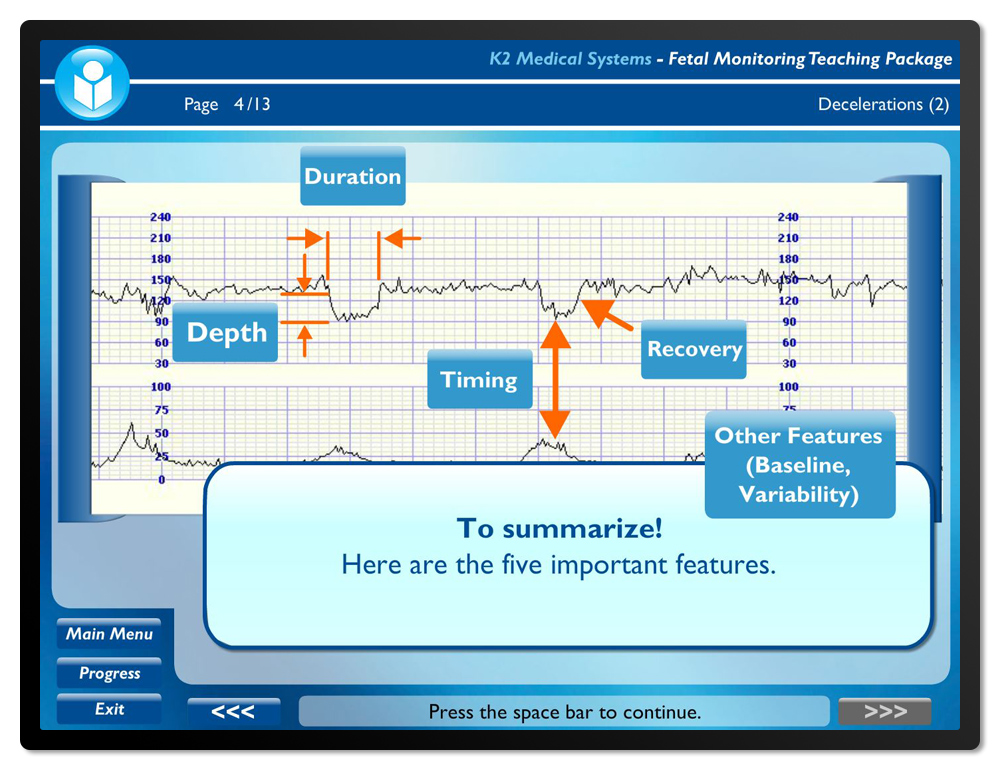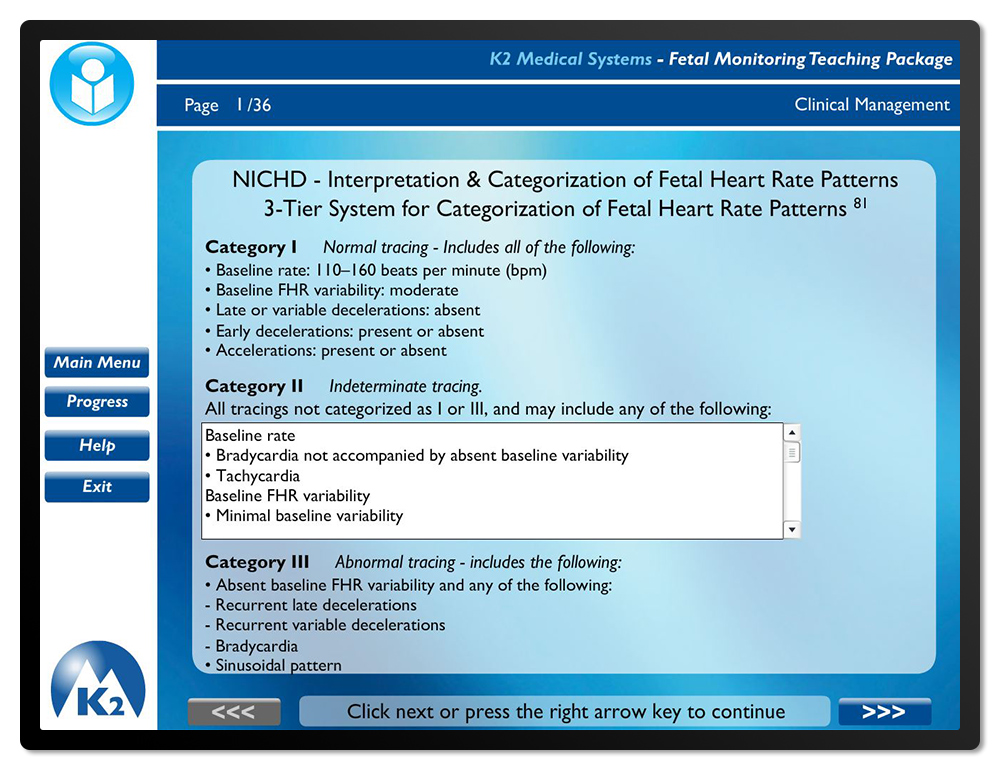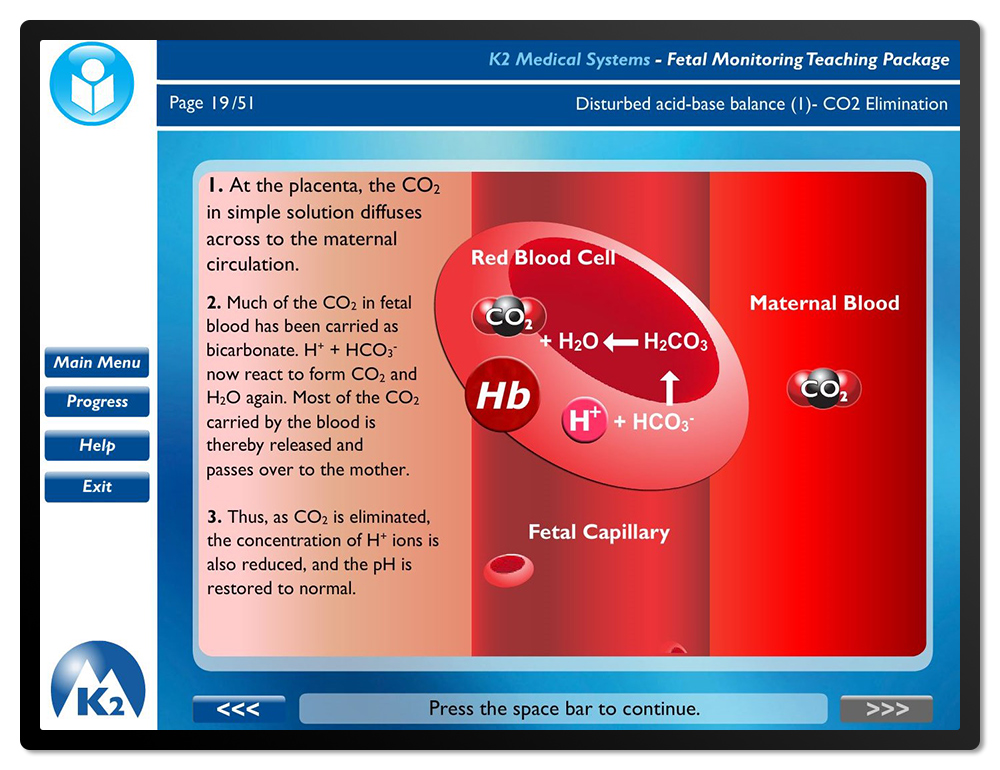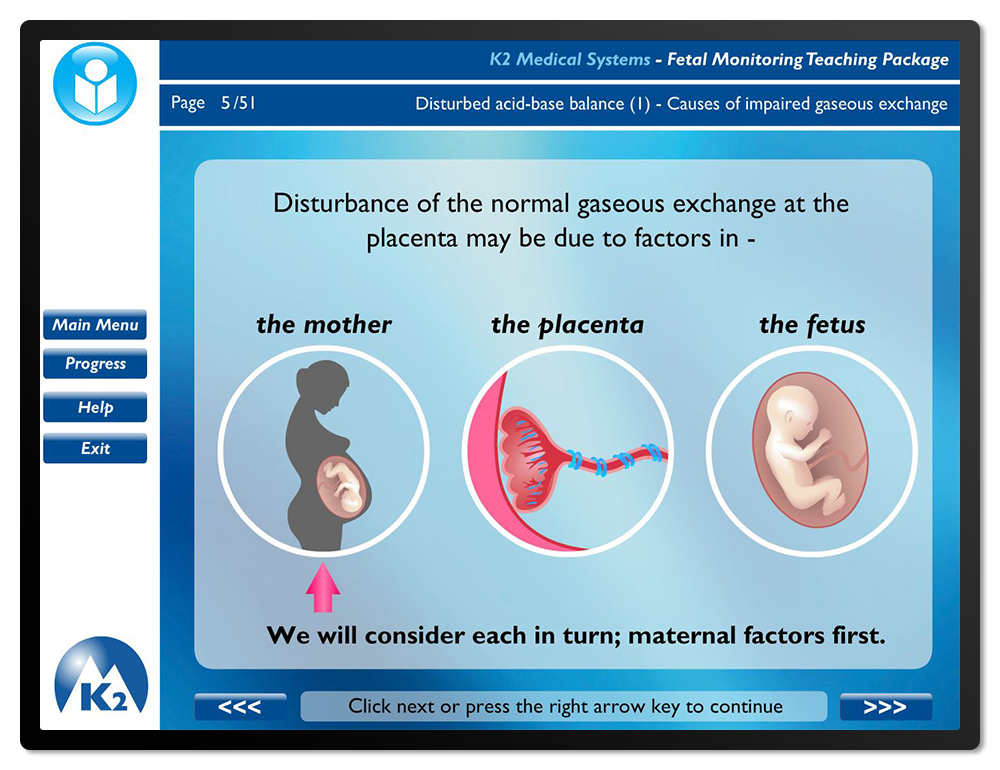PTP (Perinatal Training Program) - Fetal Monitoring Training System
Features of the K2 Perinatal Training Program
Learn, Practice, Assess, Remediate and Report
- Easy access on the web 24/7 using interactive medical graphics for an engaging learning experience.
- Training in Fetal Physiological Responses to Labor, Tracing Interpretation, Labor Management, Antepartum testing, and Error Reduction.
- Supports and reinforces the use of standardized NICHD terminology adopted by ACOG, AWHONN, JCAHO.
- Ongoing training with Labor Simulation to Practice Skills using real world cases in an interactive strip review format. Library updated regularly for ongoing improvement in competency.
- User Assessments to evaluate knowledge and provide remediation.
- Customizable learning plans.
- Auditing of user progress for compliance management.
- Nurses receive 10 CNE contact hours.
- Evaluated in Controlled Randomized Clinical Trial.
- Additional topics and contact hours in OB Emergencies. click here
- Enterprise, Group and Individual Licensing Available.
This nursing continuing professional development activity was approved by Connecticut Nurses’ Association, an accredited approver by the American Nurses Credentialing Center’s Commission on Accreditation. (10 contact hours)
Screenshot Gallery:
What can the K2 Perinatal Training Program do for you?
The K2 Fetal Monitoring Training System is a computer based training system that can be accessed over the internet, anywhere, anytime.
- Training to the 2008 NICHD EFM Guidelines. You'll learn physiology, trace interpretation, and more.
- 10 simulation cases upon license activation and 5 more cases every 6 months while you remain a member. This enables you to keep refreshing the knowledge that you have gained through use of the training system.
- On-line User Progress Reporting.
- Certificates emailed upon the completion of each chapter.
- 180,000 users of the Training System.
Why is Fetal Monitoring Training so important?
Inconsistent Interpretation & Communication of Abnormal Fetal Trends
JCAHO Sentinel Event Alert in 2004, "Preventing Infant Death and Injury During Delivery" found: 77% of all deaths or permanent disabilities in the sample group exhibited non-reassuring fetal status. Among the major root causes were communications, training and inadequate fetal monitoring
The 1997 Confidential Enquiry into Stillbirths and Deaths in Infancy (CESDI) found that: 75% of deaths during birth are due to human error. Misinterpretation of the fetal trace was the commonest failing.
Avoidable Poor Outcomes Increase Litigation & Cost
ACOG Poll in 2004 indicated:
- 76% of all OB/GYNs have been sued.
- Median lawsuit awarded $2.5million.
- Insurance Premiums Skyrocket.
Risk Management Fnd of Harvard Medical Inst found: most frequent allegation in perinatal malpractice claims is delayed diagnosis of fetal distress.
The Answer is Training!
JCAHO Recommendation:
- Develop clear guidelines for fetal monitoring of potential high-risk patients, including nursing protocols for the interpretation of fetal heart rate tracings.
- Educate nurses, residents, nurse midwives and physicians to use standardized terminology to communicate abnormal fetal heart rate tracings.
PTP Login
Topics covered:
Acid Base and Fetal Physiology
A foundation in maternal-fetal physiology is established. The learner discovers how the stresses of labor impact the fetal acid base balance. Topics include:
- basic physiology
- fetal responses to hypoxia
- normal acid-base balance
- disturbed acid-base balance
- rationale and techniques for cord blood gas analysis
- Neonatal outcomes
Intrapartum Fetal Monitoring
Learn to identify and communicate the features of the fetal heart rate tracings and understand their significance relative to fetal status, along with the possible interventions. Content teaches and reinforces NICHD standardized terminology. Topics include:
-
Purpose of Fetal Monitoring
-
Physiology
- A Systematic Approach
- Definition & Identification of FHR baseline, accelerations, variability, decelerations
- NICHD terminology
- Contraction patterns
- Abnormal FHR patterns
- Risk factors & precipitating events
- Clinical interventions
Errors and Limitations in Fetal Monitoring
This chapter is an in depth review of the limitations of fetal monitoring technology, the errors that may result, and how to recognize and guard against these errors. Topics include: Fetal Heart Rate Detection using Ultrasound and Fetal Scalp Electrodes, Uterine Activity Monitoring and Dual Heart Rate Monitoring.
Non-Stress Testing
This chapter covers the definition, purpose, procedure and indications for antepartum Non-Stress Testing. It includes identification of accelerations and a review of their physiology and significance in a tracing. Participants will learn how to identify reactive & non-reactive patterns, their significance in a tracing and appropriate responses.
Fetal Monitoring – Simulation
All the simulator training cases are real-world cases. These cases are presented to you in their entirety and you decide, blind to outcome, how they should be interpreted using the NICHD categories. You can compare your management with expert feedback and the actual clinical outcome. Feedback is provided on interpretation, physiology, and clinical management.
Fetal Monitoring – Advanced Simulator
The K2MS Advanced Simulator fully exercises the user's knowledge of the 2008 NICHD EFM guidelines, and also features exciting functionality to practice clinical management using real world labor cases. Classification of individual tracing features can be selected by the user, along with the tracing category, and labor management options. Users will receive expert feedback throughout the labor case, regarding their interpretations and interventions. Individuals can score and rate their own interpretations against the experts, and challenge them directly by being able to send comments from the simulator. Users will receive expert feedback regarding their interpretations and interventions. At the end of each case, performance scores are presented for tracing interpretation, category assignment, and clinical management. All scores and comparisons are stored for future reference.
Assessment Tool
Tests and maintains knowledge by presenting a random selection of questions for a chosen topic. Questions may be accompanied by tracings, illustrations or videos. At the end of the quizzes, results are given, along with a rationales and remediation plans to improve knowledge using the program’s broad resources.
Maternity Crisis Management Training
Exciting new content covering high-risk, low incidence OB emergencies enables clinicians to be prepared.
Antepartum Hemorrhage
- Risk factors of APH
- Main Causes of APH - placenta previa, placental abruption and vasa previa.
- The principles of APH management
Cord Presentation and Prolapse
- Risk factors of Cord Presentation and Prolapse
- Identification/Recognition of Cord Presentation and Prolapse
- Management of Cord Presentation and Prolapse
Postpartum Hemorrhage
- Risk factors of PPH
- Main causes of PPH
- The priniciples of PPH management
Shoulder Dystocia Chapter
- Definition and Causes of Shoulder Dystocia
- Maternal and Neonatal Complications
- Management and Maneuvers
- Post-Partum Care and On-going
- Risk Management
Uterine Rupture/Inversion
- Risk factors of Uterine and Inversion
- Incidence of Uterine and Inversion
- Complications of Uterine Rupture and Inversion
- Recognition of Uterine Rupture and Inversion
- Management of Uterine Rupture and Inversion














